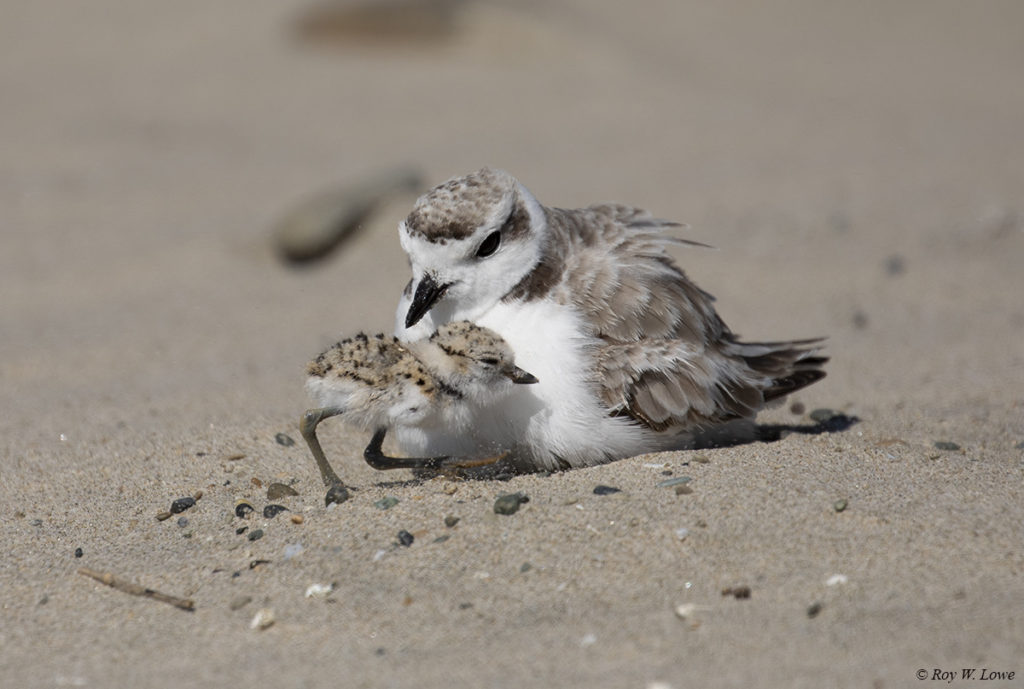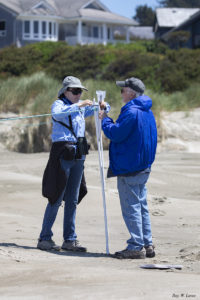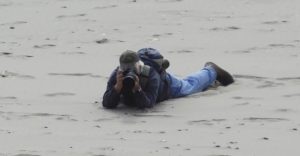
By ZACH URNESS/Salem Statesman Journal
Oregon’s cutest shorebird has made a big rally over the past two decades, from the verge of extinction to expanding its range.
Western snowy plovers, which nest in beach sand on the Oregon coast and resemble a palm-sized cotton ball with legs, reached an estimated population of 483 in the most recent count, up from as low as 76 in 2003 and just 55 in 1993.
“In general, plovers are doing very well,” said Cheryl Strong, a wildlife biologist and plover lead for the U.S. Fish and Wildlife Service in Newport. “We’ve seen them expand their range to the north and south. We now have plovers in every coastal county in Oregon. It’s quite a turnaround.”
Plovers were listed as a threatened species under the federal Endangered Species Act in 1993.

One of the main reasons for their rebound, Strong said, has been the policy of roping off 40-50 miles of dry sand on coastal beaches in management units that allow plovers to hatch and thrive in peace.
That policy, which started in 2010, began anew last week. Plover nesting season lasts from March 15 to Sept. 15. The plover management units prohibit people and dogs tramping into the dry sand of plover nesting units.
The numbers of plovers began to improve dramatically following the establishment of the roped-off units, the numbers show.
“They’re a ground-nesting bird that lays their eggs in small depressions on open sand — we call them scrapes in the sand — and rely on camouflage for protection,” Strong said. “They need undisturbed time for the young to develop.”
If the birds are disturbed by people, dogs, kites or drones — all of which are perceived as predators — they may fly away from their nest and put the eggs or young at risk.
Strong said for the most part, people have respected the beach closures. The sites are typically on remote beaches with little traffic. Even in restricted areas, people can often walk past on the wet sand part of the beach.
“We’re making great strides in reversing the decline of this species,” said Cindy Burns, a Siuslaw National Forest wildlife biologist. “But it takes all of us, so we urge people to do their part to understand nesting season rules and to share the beach this spring and summer.”
The agencies managing the birds and beach have taken other actions, such as removing invasive grasses on the coast that dramatically shrunk nesting habitat.
Even so, the birds are on the move, Strong said, with populations largely concentrated on the south coast moving north.
Plover numbers have also rebounded in Washington, up to 58 birds, while California has roughly 1,830 plovers.
In Oregon and Washington, plover numbers have surpassed the totals that would cause them to be de-listed, but for that to happen, they’d also need to reach management target numbers in each unit of California, which so far hasn’t happened, Strong said.
For now, the roped-off units will remain in place. In the future, the size and scope of the closed areas could be amended, but not at this point, Strong said.

Lincoln County volunteers help
As far as where people can see plovers in action, Strong suggested visiting South Beach near the jetty in Newport during the winter, when large flocks of plovers can come together. She also said the Portland Audubon Society does guided walks to view plovers in the wild.
“They’re a very hearty little bird,” Strong said. “If we just give them a little space, they’re quite resilient.”
Recreation restrictions occur in 15 designated plover management areas — small stretches of beach along the coastline where plovers nest or might nest — stretching from Curry County in the south to Clatsop County in the north. Combined, these areas make up about 40 to 50 miles of Oregon’s 362 miles of shoreline.
While there are no designated management areas in Lincoln County, there are active nesting areas south of the Yaquina Bay jetty and in the Bayshore area on the north side of Alsea Bay.

Nesting areas on those Lincoln County beaches are patrolled regularly by volunteers organized by retired USF&WS biologist Roy Lowe of Waldport who spend hours in the spring counting nests and alerting State Park beach rangers to areas they can rope off to alert others that there may be nests.
“Visitors have access to hundreds of miles of beaches that have no seasonal restrictions,” said Laurel Hillmann, ocean shore specialist for Oregon Parks and Recreation Department. “By planning your trip, you can enjoy the coast and help protect these special birds.”
Information on the snowy plover, including detailed maps of nesting sites, can be found on the Oregon State Parks website, oregon.gov/plovers, and on the Siuslaw National Forest website. Visitors to the Oregon Dunes National Recreation Area can review maps at its website to identify unrestricted recreation areas and information on riding motor vehicles on the sand.
The increase in plover numbers may result in nesting occurring in new or historical nesting sites. For example, visitors to Sand Lake Recreation Area may see small roped-off areas near the lake’s inlet to protect active nests, and may encounter plovers on the beach. Beachgoers are encouraged to protect these birds by restricting recreation activities to wet sand areas, avoiding roped-off nesting areas, packing all trash out and keeping dogs on leashes.
Snowy plovers declined due to:
- Habitat loss, primarily from invasive grasses. The dry, open sand areas of the coastal dunes are much smaller than they used to be.
- Human activity. The birds nest in open sand and rely on camouflage for protection. If disturbed by people or dogs, plover parents will leave their nests to avoid attracting attention to them. Too many disturbances keep them away from their nests for too long. People and dogs can also accidentally step on nests.
- Predators, including crows, ravens and foxes. Although predation is a natural process, the effects are compounded with habitat loss and human disturbance. For example, crows are attracted to areas with people, which means more crows are around to eat plover eggs.
- Zach Urness is an outdoors reporter for the Salem Statesman Journal and is host of the Explore Oregon Podcast. He can be reached at zurness@StatesmanJournal.com or 503-399-6801.


